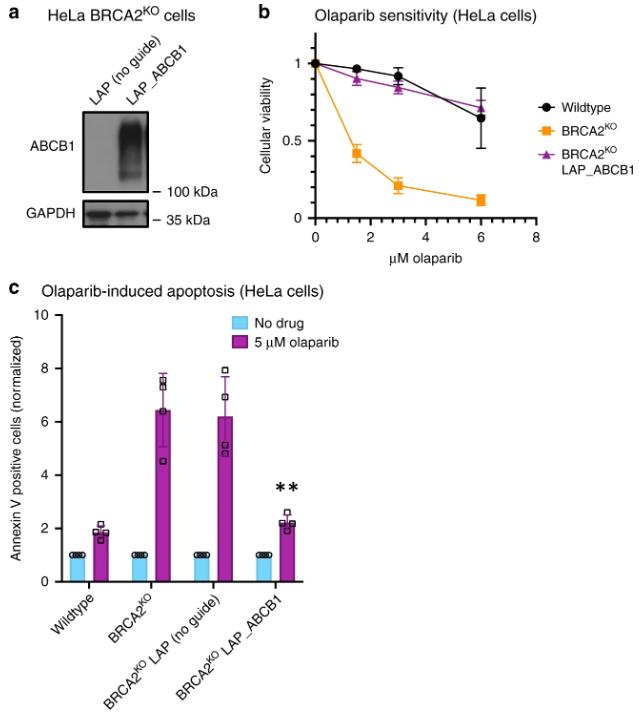Human BRCA2 Knockout Cell Line-DLD-1
Cat.No. : CSC-RT0015
Host Cell: DLD-1 Target Gene: BRCA2
Size: 1x10^6 cells/vial, 1mL Validation: Sequencing
Cat.No. : CSC-RT0015
Host Cell: DLD-1 Target Gene: BRCA2
Size: 1x10^6 cells/vial, 1mL Validation: Sequencing
| Cat. No. | CSC-RT0015 |
| Cell Line Information | DLD-1-BRCA2 (-/-) is a cell line with a homozygous knockout of human BRCA2 |
| Target Gene | BRCA2 |
| Host Cell | DLD-1 |
| Species | Homo sapiens (Human) |
| Revival | Rapidly thaw cells in a 37°C water bath. Transfer contents into a tube containing pre-warmed media. Centrifuge cells and seed into a 25 cm2 flask containing pre-warmed media. |
| Mycoplasma | Negative |
| Format | One frozen vial containing millions of cells |
| Storage | Liquid nitrogen |
| Safety Considerations |
The following safety precautions should be observed. 1. Use pipette aids to prevent ingestion and keep aerosols down to a minimum. 2. No eating, drinking or smoking while handling the stable line. 3. Wash hands after handling the stable line and before leaving the lab. 4. Decontaminate work surface with disinfectant or 70% ethanol before and after working with stable cells. 5. All waste should be considered hazardous. 6. Dispose of all liquid waste after each experiment and treat with bleach. |
| Ship | Dry ice |
Poly ADP-ribose polymerase 1 (PARPi) inhibitors are highly efficient in killing cells deficient in homologous recombination (HR). As a result, PARPi have been used successfully in the clinic to treat BRCA2-mutant tumors. However, positive responses to PARPi are not universal, even in patients with HR defects. Here, researchers present results from a genome-wide CRISPR knockout and activation screen that reveals genetic determinants of PARPi response in wild-type or BRCA2 knockout cells. Surprisingly, the report reports that depletion of the ubiquitin ligase HUWE1 or the histone acetyltransferase KAT5 (the top hits from the screen) strongly reverses PARPi sensitivity caused by BRCA2 deficiency. The researchers identify distinct mechanisms of resistance, where HUWE1 loss increases RAD51 levels to partially restore HR, while KAT5 depletion rewires double-strand break repair by promoting 53BP1 binding to double-strand breaks. This work provides a comprehensive set of putative biomarkers that advance the understanding of PARPi responses and identifies novel pathways of PARPi resistance in BRCA2-deficient cells.
Few studies have reported proteins that cause PARPi resistance when overexpressed. Interestingly, however, the best gene in the researchers' screen, ABCB1, had previously been identified as a mechanism of PARPi resistance. This gene encodes the protein MDR-1 (multidrug resistance protein 1), a drug efflux pump whose overexpression has been associated with acquired resistance to olaparib in ovarian cancer cell lines. To validate these results, the researchers generated HeLa BRCA2KO cells with transcriptional activation of the ABCB1 gene (Figure 1a). They found that the BRCA2 knockout, ABCB1-overexpressing cell line was as resistant to PARPi as the BRCA2-proficient parental HeLa line (Figure 1b). Previously, PARPi treatment has been shown to induce apoptosis in BRCA2-deficient cells. Consistent with this, the study found that olaparib treatment led to a more than sixfold increase in cells positive for Annexin V, a marker of apoptosis, in BRCA2 knockout cells. However, overexpression of ABCB1 restored olaparib-induced apoptosis to control levels (Figure 1c). Overall, these findings validated the results of the CRISPR activation screen.
 Figure 1. Overexpression of ABCB1, the top hit from the CRISPR activation screen, causes PARPi resistance in BRCA2 knockout cells. (Clements K E, et al., 2020)
Figure 1. Overexpression of ABCB1, the top hit from the CRISPR activation screen, causes PARPi resistance in BRCA2 knockout cells. (Clements K E, et al., 2020)

Our promise to you:
Guaranteed product quality, expert customer support.
 24x7 CUSTOMER SERVICE
24x7 CUSTOMER SERVICE
 CONTACT US TO ORDER
CONTACT US TO ORDER